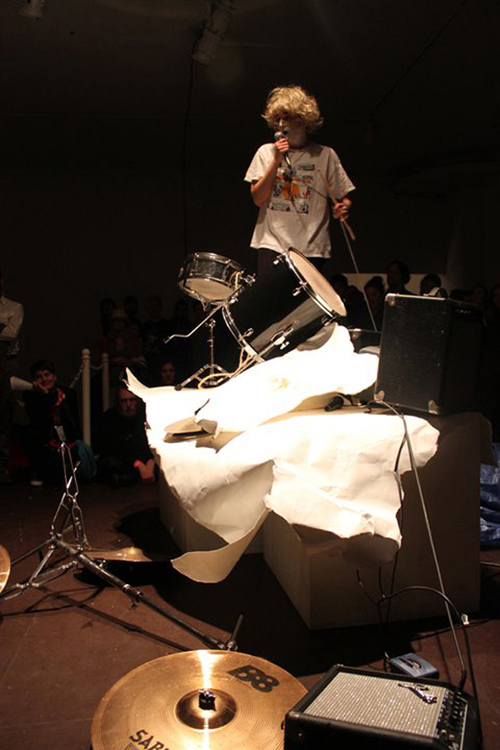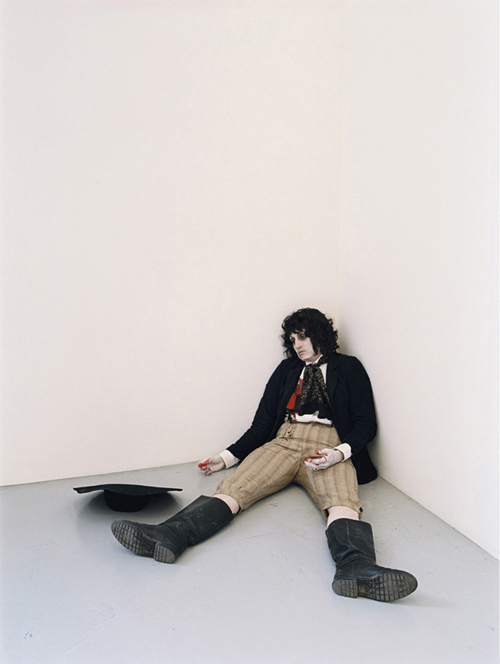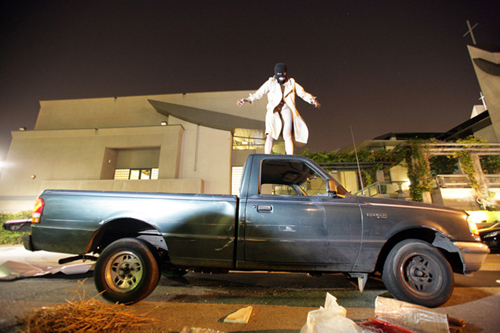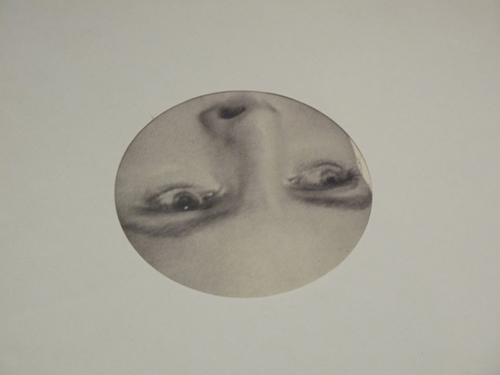*Ed. Note: This is Part 2 of a two-part conversation between Marissa Perel and Dawn Kasper. To read Part 1, click here.
MP: So, this work [at the Whitney Biennial] is changing how you see yourself as a performer, and how you present yourself to an audience?
DK: Yes, definitely. As I said, before I would do an isolated performance, and then go home and collect myself, chill out, or whatever. And now it’s like I go home, but going to the Whitney is essentially a job. How is it different than anyone else working here on the fourth floor? I’m not really doing anything different. So with that in mind, this is a performance, and there are questions like “how am I not myself?” There was this group of teens, all hanging out here, chatting, looking at me, and one of the girls asked, “are you acting?” Teenagers that come to my piece end up asking me that. It stops me dead in my tracks, like “am I acting? I don’t know!” I think maybe I am, but I don’t know because I don’t feel like I am. Is it this environment? Is it the fact that there are people? The music? The art? Because this is, essentially, my stuff—my living space. But then right there, there are people coming, and there’s someone else’s artwork, and this is someone else’s establishment. No matter how hard I try to ignore the situation and do my thing, something will always dismantle it. Questions about art, my position in art, what I’m making come up daily.
MP: Does it make you think about re-contextualizing your work or your persona?
DK: That’s an incredible question. Yes, I’ve been thinking about my work in a different manner since being here. I feel like this is definitely a stepping stone, or really a milestone. In order to do the next work I want to do, I needed to do this. I’m interested in durational performance, and it’s a bit blurred that in fact this is durational performance. It does address issues with respect to performance art and its lineage. The mess, clutter, bits of text and images, the “work-in-progress” feel form a subtext about durational performance and its effect on artists in this day and age–on my generation. Everyone’s talking about the word “performance” in lights, but I don’t see a huge need to compartmentalize it. I think it’s interesting to explore the degrees of ability that performers have under the umbrella term of “performance art.” Obvious forms are theater and dance, but there are also other approaches to performance art. Even within those forms, there are subtexts or sublevels of interest. I’m fascinated with exploring performance art in the many facets of what it has to offer.

Dawn Kasper. "You, Me, and Them" performance at LACE. C-print of performance. Image courtesy the artist.
In terms of my history with performance, it’s always been the means for me to realize art. Like when we talked about body modification, I feel like that work got me to the next work, and then that got me to the next work, and then I get inspired by other artist’s work. I’m learning as I go that there are artists that inspire me and that have inspired me through the years, and it’s interesting how I’m finding through my practice that it’s actually opening up doors to other ways of working. It’s coming together at different times. This particular piece is a lot like being in a relationship. You have to take responsibility for your baggage and whatever you’re bringing to the relationship, and if something the other person does is annoying you, it’s usually that you’re annoying yourself because it’s triggering some muscle memory or previous experience, based on some expectation that you have. It’s psychological.
MP: Or something from your childhood and the way you were treated?
DK: Totally! Part of this is that it’s an investigation into getting an outside perspective of what’s happening in my “relationship,” my practice.
MP: It’s amazing to hear it put in these terms [laughs].
DK: Right? Because a lot of this stuff is my studio, and it’s pretty much everything I own, but I’m noticing that my experience of my “stuff” is based on all kinds of attachments.
MP: Oh! I wanted to tell you way before that when I was waiting for you, these two women came up, and one of them was like, “This is just like a boy’s stuff, like a boy with his stuff, his stuff in the space. I can’t handle it.” But then it seemed like she didn’t want to leave it.
DK: A boy with his stuff!
MP: Then the other one was like, “Are you sure it’s a boy?” And she was like, “I’m not sure.” And then they looked at the video and they were like, “Maybe it’s not a boy.” [laughter] And then the one who said “It’s a boy” said, “It might not even be the boy’s stuff, it might just be stuff, or it might be someone else’s stuff that he has here.” And I just listened to them for awhile, trying to conjecture what it was.
DK: That’s really interesting. I didn’t think of it as gendering stuff!
MP: Stuff equals boy, or something.
DK: Clutter.
MP: Clutter, or the ability to take up space, or like this on the wall—something about that.
DK: Well a lot of it too is that I think people don’t recognize that this is me in the work, and a lot of it looks masculine.
MP: How does it look masculine?
DK: Well because that looks like a guy, and I kind of look like a guy there…? But then there are breasts.
MP: You’re wearing tights.
DK: It’s funny to process it even now because I didn’t think of it. I don’t think of gender, so it’s a bit…I’d like to think it’s ambiguous. You’ve opened up something because I never thought of how my objects reflect my gender. I mean this goes a little bit full circle to what we were talking about, whether this piece has changed my perspective on my practice.
MP: Do you feel like you’ve made it?
DK: Oh, wow, that’s a great question. Yes and no. Like—yes, definitely. Yes. I mean this feels like a huge accomplishment and I’m still in it—not to talk about it in the past tense—but even just being here is a huge, huge honor. I’m so grateful. Also, my friends who have helped me and been so supportive, and my new friends who have helped me and been so supportive, Jay and Elisabeth [the curators] being so supportive. I am interested in questioning, “what is success?” It’s relative. It’s successful if you get a good meal, or it’s successful if you get to meet up with a friend that you’ve been trying to meet up with for months, or you get to make a new friend. Basically I’m learning that it’s not so cut-and-dry. It’s not always what it seems.
MP: It takes a very strong individual to do this, not just exposing your things, but to talk to people every day. When I came to interview you, I thought I’d watch you make a collage or something, or we’d put on masks [laughter]. I didn’t expect to see all these points of convergence.
DK: The room has become a sort of catalyst for this happenstance of intersections, things, time frames. I’m fascinated by how Mike Kelley, Paul McCarthy, or Jason Rhoades have made immersive environments. I don’t feel like I’m addressing anything new. It’s not a new topic. I’m not suggesting that this is anything that hasn’t been done before [laughs].
MP: The room makes me think of Dieter Roth most.
DK: I love Dieter Roth! I have been thinking about his work in relationship to archiving the room. I recently got gallery representation, so one of my next projects is archiving all of the items in this piece.







